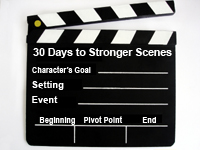Writing Scenes: Planning
Featured Today in Fiction Notes Store
 30 Days to a Stronger Scene Table of Contents
30 Days to a Stronger Scene Table of ContentsHere’s a basic template for planning a scene. Later, when you get ready to write the scene, you might want to list individual actions in what’s called a “beat sheet.” But when you’re just planning scenes, you want these basics.
- Basics
- Setting:
- Where are we
- What is the Occasion
- Who is present:
- What happens, or what is the plot event
- Emotion
- Emotional Pulse/subtext running through the scene:
- Emotion at Beginning:
- Emotion in middle
- Emotion at End:
- Plot
- Plot Goal:
- Plot Complication:
- Plot Complication:
- Plot Complication:
- Disaster at end of scene:
- What gets reviewed in between scenes This is the emotional reaction to what just happened and can be covered in a single word. (Angry, she went. . . ) or can take a couple pages. After the emotional outburst, the character thinks about everything and decides what to do next, which leads to. . .
- Goal of next scene:

These last two posts were really helpful. I’ve been thinking a lot lately about how some of my scenes drag too much. There’s too much talking and not enough action. I fall into that problem too much. Today hopefully I’ll fix one chapter. I had to look at totally changing the setting and who is present to make it more exciting.
Ah, dragging scenes, the bane of our life. Recognizing that some drag is the beginning of a great revision, though. So, it’s good.
Darcy
Thank you so very much for this. My problem is that my scenes are always too short. I wish I’d found this earlier.